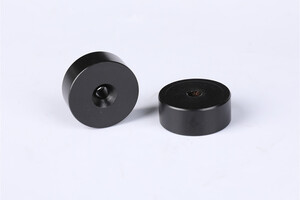The Steps Of Strong Neodymium Magnets Making Process
Body
Curie Temperature:
“The curie temperature, or curie point, is the temperature at which magnetic materials have a change in their magnetic properties and become paramagnetic. In magnetic metals, magnetic atoms are aligned in the same direction and reinforce each other’s magnetic field. Raising the curie temperature changes the arrangement of the atoms.
“Coercivity increases as the temperature increases. Though neodymium magnets have high coercivity at room temperature, it goes down as the temperature rises until it reaches the curie temperature, which can be around 320o C or 608o F.
“Regardless of how strong neodymium magnets may be, extreme temperatures can alter their atoms. Prolonged exposure to high temperatures can cause them to completely lose their magnetic properties, which begins at 80o C or 176o F.
Chapter Three – How are Strong Neodymium Magnets Made?
“The two processes used to manufacture neodymium magnets are sintering and bonding. The properties of the finished magnets vary depending on how they are produced with sintering being the best of the two methods.
How Neodymium Magnets are Made
Sintering
Melting:
“The Neodymium, Iron and Boron are measured out and put in a vacuum induction furnace to form an alloy. Other elements are added for specific grades, such as cobalt, copper, gadolinium, and dysprosium to assist with corrosion resistance. Heating is created by electrical eddy currents in a vacuum to keep contaminants out. The neo alloy mixture is different for each manufacturer and grade of neodymium magnet.
Powdering:
“The melted alloy is cooled and formed into ingots. The ingots are jet milled in a nitrogen and argon atmosphere to create a micron-sized powder. The neodymium powder is put in a hopper for pressing.
Pressing:
“The powder is pressed into a die slightly larger than the desired shape by a process known as upsetting at a temperature of about 725o C. The larger shape of the die allows for shrinkage during the sintering process. During pressing, the material is exposed to a magnetic field. It is placed in a second die to be pressed into a wider shape to align the magnetization parallel to the direction of pressing. Some methods include fixtures to generate magnetic fields during pressing to align the particles.
“Before the pressed magnet is released, it receives a demagnetizing pulse to leave it demagnetized to create a green magnet, which easily crumbles and has poor magnetic properties.
Sintering:
“Sintering, or frittage, compacts and forms the green magnet using heat below its melting point to give it its final magnetic properties. The process is carefully monitored in an inert, oxygen-free atmosphere. Oxides can destroy a neodymium magnet’s performance. It is compressed at temperatures reaching 1080° C but below its melting point to force the particles to adhere to each other.
“A quench is applied to rapidly cool the magnet and minimize phases, which are variants of the alloy that have poor magnetic properties.
Machining:
“Sintered magnets are ground using diamond or wire cutting tools to shape them to the correct tolerances.
Plating and coating:
“Neodymium oxidizes quickly and is prone to corrosion, which can remove its magnetic properties. As a protection, they are coated with plastic, nickel, copper, zinc, tin, or other forms of coatings.
Magnetization:
“Though the magnet has a direction of magnetization, it is not magnetized and has to be briefly exposed to a strong magnetic field, which is a coil of wire that surrounds the magnet. The magnetizing involves capacitors and high voltage to produce a strong current.
Final Inspection:
“Digital measuring projectors verifies the dimensions and x-ray fluorescence technology verifies the thickness of the plating. The coating is tested in other ways to ensure its quality and strength. The BH curve is tested by a hysteresis graph to confirm full magnification.
Bonding
“Bonding, or compression bonding, is a die pressing process that uses a mixture of neodymium powder and an epoxy binding agent. The mixture is 97% magnetic material and 3% epoxy.
“The epoxy and neodymium mixture is compressed in a press or extruded and cured in an oven. Since the mixture is pressed into a die or put through extrusion, magnets can be molded into complex shapes and configurations. The compression bonding process produces magnets with tight tolerances and does not require secondary operations.
“Compression bonded magnets are isotropic and can be magnetized in any direction, which includes multi-polar configurations. The epoxy binding makes the magnets strong enough to be milled or lathed but not be drilled or tapped.
Radial Sintered
“Radially oriented neodymium magnets are the newest magnets on the magnet market. The process for producing radial aligned magnets has been known for many years but was not cost effective. Recent technological developments have streamlined the manufacturing process making radially oriented magnets easier to produce.
“The three processes for manufacturing radial aligned neodymium magnets are anisotropic pressure molding, hot pressing backward extrusion, and radial rotating field alignment.
“The sintering process ensures that there are no weak spots in the magnets structure.
“The unique quality of radially aligned magnets is the direction of the magnetic field, which extends around the perimeter of the magnet. The south pole of the magnet is on the interior of the ring, while the north pole is on its circumference.
“Radially oriented neodymium magnets are anisotropic and are magnetized from the inside of the ring to the outside. Radial magnetization increases the rings magnetic force and can be shaped into multiple patterns.
“Radial neodymium ring magnets can be used for synchronous motors, stepping motors, and DC brushless motors for the automotive, computer, electronic, and communications industries.
As an professional neodymium magnet manufacturer, we will provide the reasonable Ndfeb Magnet Price, Welcome to consult.











Comments